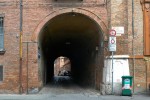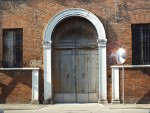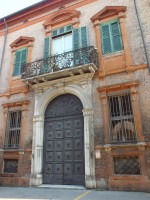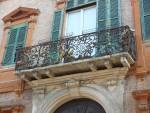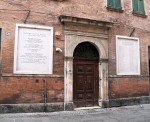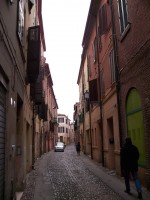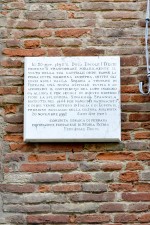Pawn banks
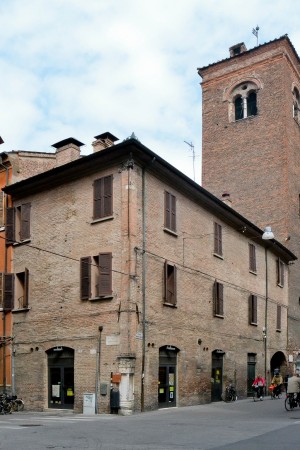
Ripa Bank, between Via Ripagrande and Corso Porta Reno. Photograph by Edoardo Moretti, 2015. © MuseoFerrara
In the Este period, three pawn banks operated in Ferrara, located in strategic areas for the economic life of the city.
1.History
Throughout the State of the House of Este, the origin of the Jewish Communities is linked to the management of pawn banks, documented in Ferrara since the 13th century. At the end of the fifteenth century "the presence of local Jews was still regulated by the conduct of the banks which established, together with the manner in which the bankers were to exercise the loan, the amount of the tribute due to the Ducal Chamber and the privileges granted to the Jewish Community. The conduct and with it, at least theoretically, also the residence permit had a variable duration, for the most part ten years, and at its expiration it had to be renegotiated" (Leoni 2000, p. 278). Spanish Jews arriving in Ferrara in 1492 welcomed by the dukes Ercole I d'Este and Eleanor of Aragon enjoyed broader privileges than Italian Jews: the ducal decree in favour of Spanish Jews did not expire, they did not have to pay taxes, they could create merchant companies and companies with both Italian Jews and Christians, they could contract the collection of duties and exercise any trade. The skill of Sephardic merchants and craftsmen would have strengthened the economy of the Duchy, which had been open to immigrants since 1435, under the Marquis Nicolò III (1383-1441).
In the fifteenth and sixteenth centuries, three banks operated in Ferrara, strategically located in the cornerstones of the city's economic life: the Bank of Ripa takes its name from the street of the same name, near the port of San Paolo, where the current Via Ripagrande crosses today's Corso Porta Reno (formerly Via di San Paolo); the Bank of Sabbioni overlooks the street of the same name (now Mazzini), a stone's throw from the square, in the building where the synagogue would rise in 1481; the Bank of Carri was at the intersection of Via San Gregorio (now Via Cammello) and Via Grande (Via Ripagrande, in this section Via Carlo Mayr), in a building long owned by the Christian Carri family. It is also called the "bocha del Canal", a name that recalls the dense network of canals to the north of the ancient town.
2. Management and organisation
The anonymous Lender's Book suggests the location of the counter in the most vital area of the city, with the entrance rather reduced to prevent any break-ins and protected by a curtain to ensure confidentiality; the interior must be illuminated and equipped with a well calibrated scale. In another adjoining room with very narrow access, the assets held in pledge were placed.
From a decree of Borso d'Este of 1454 we know that the management of individual banks was in the hands of one or more ‘main lending’ partners. "In any case, those who took over the management of a bank, whether they were an isolated banker or a company of merchant-lenders, had the right to designate one or more additional partners" and to hire staff. Often the banker's partners came from other cities, forming "intestate or intercommunal" companies that offered security guarantees thanks to the division of risk. "[...] the management of credit companies required the presence of farmhouses, factors, cashiers, employees, supervisors and servants. The banker's family gave work to some servants, to a school teacher and often hosted, for patronage or for reasons of prestige, a Rabbi who officiated in the banker's private synagogue and, if necessary, acted as legal advisor. Often a master of music and dance was also part of the group". (Leoni 2000, pp. 279-282).
The owners of the banks came from families long established in Ferrara or in other parts of the Estense State, such as the Norsa, the Finzi and, later, the Fano. Jewish bankers were not afraid of competition from the Monte di Pietà, created in 1507, so much so that the small pledge loan for the less affluent classes was accompanied by another specialisation: operating credit, aimed at the long-term financing of artisans, merchants and farmers. Around the mid-sixteenth century, the Jewish bankers of Ferrara also financed their colleagues in other cities, as well as small and medium-sized merchant companies formed by Italian and German Jews and, sometimes, Portuguese. Leone di Gadilia Nigro-Yahia da Lisbona obtained in 1529 the conduct of the Banco di Massa Fiscaglia, thanks to privileges already granted and confirmed by Duke Alfonso I (in government 1505-1534).
3. Between the 17th and 18th Centuries
The sense of precariousness that had accompanied the activities in the fifteenth century, then dormant in the sixteenth century, reappears in 1598, at the time of the devolution of Ferrara to the State of the Church, a moment that found the Jewish Community afraid and full of uncertainties, to become even more acute between 1624 and 1627, with the creation of the Ghetto. Those who lived in the city outside that enclosure had to abandon houses and activities, including the Budrio, managers of the Banco dei Carri and the Rossi of the Banco della Ripa, who found new accommodation in the Via Gattamarcia (Via Vittoria), where they moved while preserving the original ‘company’.
The importance of the pheneratic banks led by Jews remained so in the eighteenth century, despite the heavy restrictions imposed, in support of the aristocracy and the people. Just to give an example, in 1779 Banco Coen managed the collection of the rents of the real estate owned by the Priory of San Romano, using "even receipts prepared for printing to the credit of His Eminence the Most Rev. Mr. Cardinal Guido Calcagnini Bishop of Osimo, and Cingoli, and Modern Prior Commander of the aforementioned Priory, and of San Pietro di Coparo... once again the ecclesiastical authority absolved itself of the use of Jewish lenders, hiding behind the formula commodatis et necessitatis used by Pope Niccolò. […] The profession had gradually taken on its own recognized role also at the social level […]” (Graziani Secchieri 2000, p. 24).
Bibliography
- Graziani Secchieri, Laura, I prestatori. I banchi di pegno e le famiglie ebraiche a Ferrara e nella politica estense, in «Ferrara. Voci di una città», 12, 2000, pp. 19-24 Vai al testo digitalizzato
- Leoni, Aron, Gli Ebrei a Ferrara nel XVI secolo, in Prosperi, Adriano - Chiappini, Alessandra (a cura di), Storia di Ferrara. VI. Il Rinascimento. Situazioni e personaggi, Corbo, Ferrara 2000, pp. 278-311
- Santini, Alfredo (a cura di), Etica, banca, territorio: il Monte di Pietà di Ferrara, Cassa di Risparmio di Ferrara - Federico Motta, Ferrara / Milano 2005 , pp. 80-105
Fototeca
Related places
Related Themes
Compiling entity
- Istituto di Storia Contemporanea di Ferrara
Author
- Edoardo Moretti
- Sharon Reichel

